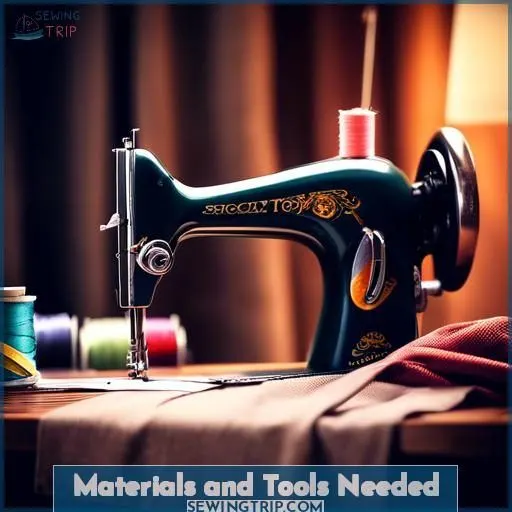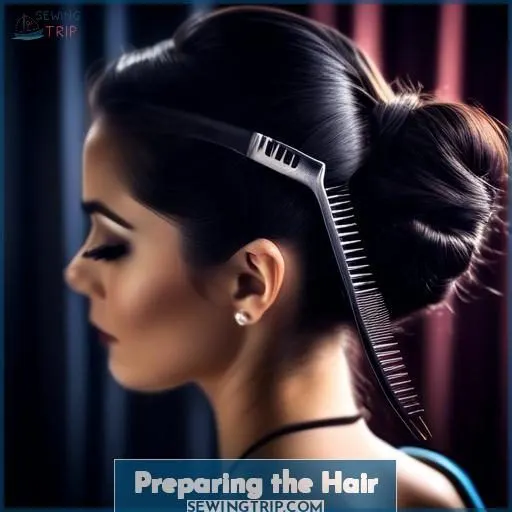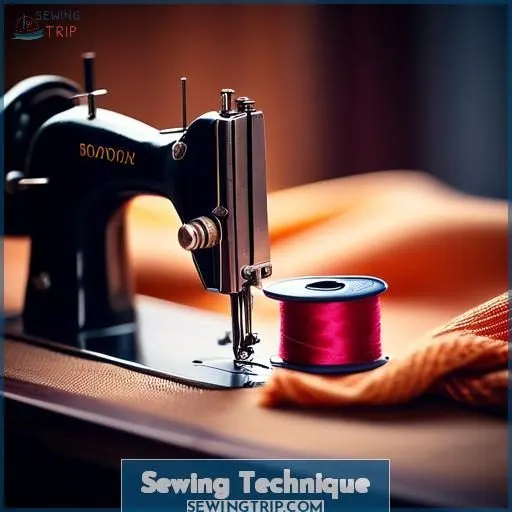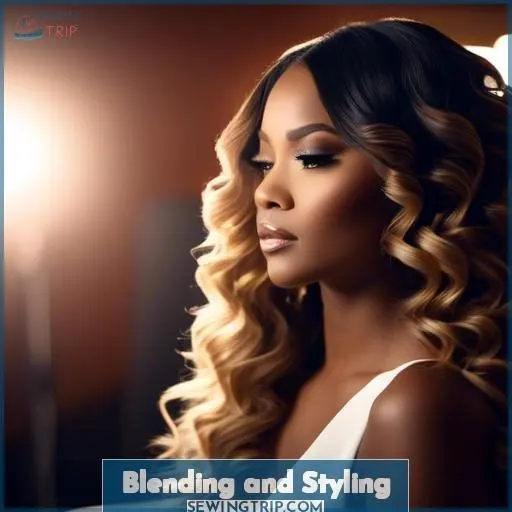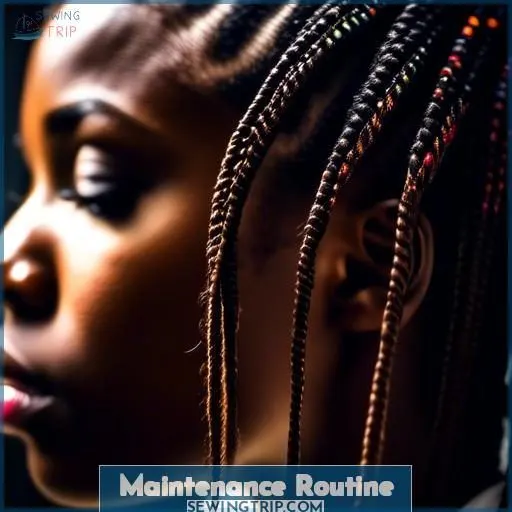This site is supported by our readers. We may earn a commission, at no cost to you, if you purchase through links.
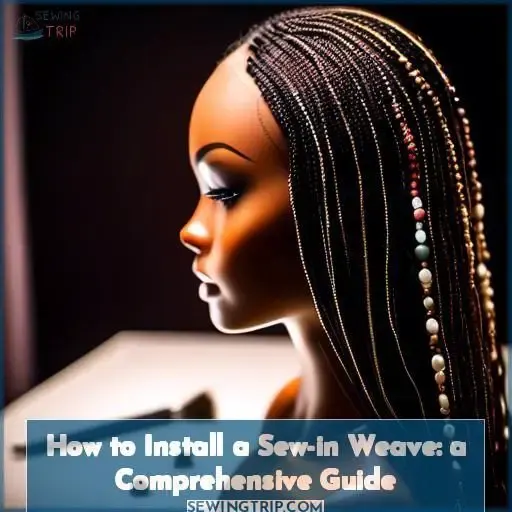
To install a sew-in weave, you’ll need high-quality human hair extensions, strong thread, sharp needles, and compatible hair texture. Start by preparing your hair by washing and applying hot oil treatment, trimming, and braiding in cornrows.
Measure and cut the wefts to match your tracks, and sew them onto your braids, adjusting tension as needed. Blend your natural hair with the extensions by combing, applying polishing gloss, and flat ironing. Don’t forget to secure the ends to prevent shedding.
For a perfect blend, cover your tracks, and maintain your weave with a washing and conditioning routine. Mastering the art of sew-in weaves takes practice, but with this guide, you’ll be on your way to a flawless new look.
Table Of Contents
Key Takeaways
- Prepare your hair by washing, applying a hot oil treatment, trimming, and braiding in cornrows.
- Measure and cut the wefts to match your tracks, and sew them onto your braids, adjusting the tension as needed.
- Blend your natural hair with the extensions by combing, applying a polishing gloss, and flat ironing.
- Maintain your weave with a washing and conditioning routine, washing every 1.5-2 weeks, diluting the shampoo with water, and applying hot oil treatments to the braids and extensions.
How to Install Sew In?
To install a sew-in weave, you’ll need to prepare your hair by washing and blow-drying it. Then, braid your hair down, creating a cornrow pattern. Measure the track for the first row and sew it onto the braid, using a hook needle and weaving thread. Repeat this process for additional rows until you reach the crown.
Comb your leave-out to cover the tracks and apply a polishing gloss to blend your natural hair with the tracks. Trim the ends of the extensions to define the layers and frame your face.
For maintenance, wash your hair every 1.5 to 2 weeks, using a squeeze bottle with diluted shampoo. Apply a hot oil treatment, rinse, and let your hair air dry. Use a comb attachment to blow dry and flat iron your leave-out. Bump the ends of the tracks with the flat iron and put your hair in a doobie wrap or silk scarf for sleeping.
Materials and Tools Needed
To install a sew-in weave, you’ll need several materials and tools. These include:
- Weaving hair: High-quality human hair extensions suitable for weaving.
- Thread selection: Choose a thread that matches the color of your hair and is strong enough to hold the extensions in place.
- Needle size: A sharp, large-eyed needle will make threading the wefts easier.
- Track length: Measure the length of the tracks you’ll be sewing the wefts onto.
- Hair texture: Consider the texture of your natural hair when selecting the weaving hair to guarantee a seamless blend.
- Sewing machine: A reliable sewing machine with a needle that can handle the thickness of the weaving hair.
- Needle: A large-eyed sewing needle for sewing the wefts onto the tracks.
- Fabric: Choose a fabric for the tracks that’s comfortable and breathable, such as silk or satin.
- Stitch: A strong, even stitch that can hold the wefts in place.
- Anvil: A flat, hard surface to secure the needle when not in use.
These materials and tools are essential for successfully installing a sew-in weave.
Preparing the Hair
To prepare your hair for a sew-in weave, start by washing it and applying a hot oil treatment. Then, trim your hair and braid it up, leaving out bangs and enough hair in the crown to cover tracks. Braid your hair straight back in cornrows and connect the braids into one going across the back of your head.
Washing and Treating
To prepare your hair for a sew-in weave, you’ll need to start with a clean slate. Begin by washing your hair and applying a hot oil treatment to nourish and soften the strands. Afterward, trim your hair to make sure it’s healthy and ready for the weave. When braiding your hair, leave out bangs and enough hair in the crown to cover the tracks. Braid your hair straight back in cornrows and connect the braids into one going across the back of your head.
For the weaving process, you’ll need a walking foot to make sure multiple fabric layers are fed evenly. This attachment helps prevent puckering, stretching, and skipped stitches, making it ideal for sewing bulky, slippery, or knit fabrics. To install a walking foot, remove the presser foot holder from your machine shank and place the walking foot attachment on the shank, aligning the moveable lever with the needle screw.
Once you’ve prepped your hair and have the necessary tools, you can begin the sewing process. Start by measuring the track for the first row from one side of the braid to the next and cut the track to the correct length. Sew the track onto the braid, repeating this process for each additional row. Stop sewing when you reach the crown.
To blend your weave with your natural hair, comb the leave-out down to cover the tracks and apply a polishing gloss. Flat iron your natural hair to blend with the tracks, trimming the ends of the extensions to define layers. Bump under the ends with a flat iron to create a natural appearance.
To maintain your sew-in weave, wash your hair every 1.5-2 weeks, diluting shampoo with water and washing the braids. Apply a hot oil treatment to the braids and extensions, blow dry with a comb attachment, and flat iron the leave-out and bump ends of the tracks.
Braiding and Sectioning
After pampering your mane with a luxurious wash and oil treatment, it’s time to embark on the intricate art of braiding and sectioning. Here’s how to establish a flawless foundation:
- Divide and Conquer: Section your hair, leaving out fringes and sufficient crown hair to conceal the tracks later.
- Cornrow with Caution: Utilize diverse cornrow patterns, making sure they’re secure but not painfully tight.
- Strategic Leave-Out: Select leave-out styles judiciously to achieve a seamless blend with your weave.
- Braid for Triumph: Perfect braiding techniques to achieve a flat base, avoiding the dreaded helmet head.
Measuring and Cutting the Wefts
To measure and cut the wefts for a sew-in weave, follow these steps:
- Determine the track width: Measure the width of the track where the wefts will be sewn in. This will help you determine the appropriate length for your wefts.
- Weft placement: Decide on the placement of the wefts in the track. You may choose to place one weft underneath the track of beads and 1-2 wefts on top to hide the track.
- Length adjustment: Adjust the length of the wefts to match the track width. If the wefts are too long, fold them to fit the track. If cutting is necessary, use fine hairdressing scissors to make neat, straight cuts along the designated line.
- Even distribution: Make sure that all wefts are cut to the same length for even distribution. This will prevent unevenness in the final result.
- Weft spacing: Measure the spacing between the wefts to make sure that they’re evenly distributed along the track. This will create a smooth, seamless appearance.
- Sewing project: Keep in mind the specific sewing project you’re working on, such as a button fly pattern or button fly installation, as this may influence the length and placement of the wefts.
- Practice: Experiment with different fabrics and wefts to find the ideal settings for your walking foot.
Remember to brush the hair extensions gently before cutting to remove any tangles or knots.
Sewing Technique
To install a sew-in weave, you’ll need to follow a specific sewing technique. Here’s a step-by-step guide:
-
Starting the First Row: Sew the first track in line with your perimeter braid. Lay the track smoothly in line with your braid.
-
Adding Additional Rows: Measure the track for each additional row from one side of the braid to the next. Cut the track to the correct length. Sew the track onto the braid, repeating this process for each additional row.
-
Securing Ends: Stop sewing when reaching the crown. This will prevent the weave from becoming too tight, which can cause damage to your natural hair.
Remember to be gentle when sewing to avoid damaging your hair. If you’re unsure about any part of the process, it’s best to consult with a professional stylist for guidance.
Starting the First Row
To start the first row, choose a weft size that suits your hair’s density and texture. Consider head size to avoid track visibility. Cut the track to the correct length. Sew the track onto the braid, ensuring it’s secure.
For blending different textures, use ring or spring snap fasteners. If you’re sewing jeans, use a hammer to secure vintage jeans snaps.
Adding Additional Rows
To add additional rows, follow these steps:
- Measure the track placement for each row from one side of the braid to the next.
- Cut the track to the correct length.
- Sew the track onto the braid, making sure the tension is adjusted properly.
- Repeat for each additional row, stopping when reaching the crown.
Remember to adjust weft width and spacing for a seamless look, similar to quilting techniques. Use a hole punch or fly placket for waterproof jackets to make sure the fit is secure.
Securing Ends
When you’re rounding the final corner of your sew-in weave, think of it as the last lap in a marathon. Now’s the time to employ those finishing techniques that guarantee longevity. Trim the weft to customize length, secure it tightly to prevent shedding, and ponder styling options. It’s like putting the cherry on top—your masterpiece is almost ready to debut.
Blending and Styling
To blend your sew-in weave with your natural hair, follow these steps:
- Comb your natural hair to remove any tangles or knots.
- Apply a polishing gloss to your natural hair to make it shine and blend with the tracks.
- Flat iron your natural hair to smooth it out and make it lay flat against your scalp.
- Trim the ends of the extensions to define layers and blend with your natural hair.
- Bump the ends of the tracks with a flat iron to create a natural-looking texture.
By following these steps, you can achieve a seamless blend between your natural hair and the sew-in weave, making it look more natural and stylish.
Covering Tracks
To cover tracks and blend your extensions with your natural hair, follow these steps:
- Leave out hair to cover tracks: Comb your natural hair and leave out enough to cover the tracks.
- Apply polishing gloss: Apply a polishing gloss to your natural hair to blend it with the extensions.
- Flat iron: Flat iron your natural hair to blend it with the tracks.
- Trim extensions: Trim the ends of your extensions to define layers and make them look more natural.
- Bump under ends: Bump the ends of your extensions with a flat iron to create a natural look.
Remember to wash your hair every 1.5-2 weeks, dilute your shampoo with water, and apply a hot oil treatment to the braids and extensions. Blow dry with a comb attachment and flat iron the leave-out and bump the ends of the tracks.
Maintenance Routine
Maintaining your sew-in weave requires regular washing and conditioning to keep both your natural hair and the extensions in tip-top shape. You’ll also need to apply treatments, such as hot oil treatments, to guarantee the vitality and long-lasting quality of your weave.
Washing and Conditioning
To preserve your sew-in weave, it’s mandatory to cleanse it regularly. A sensible guideline is to cleanse your sew-in every 7-10 days, as the extensions and your scalp should be washed more frequently when wearing a sew-in. Here’s a step-by-step guide on how to wash and condition your sew-in weave:
- Washing: Apply a clarifying shampoo to your scalp and gently massage it in. Rinse thoroughly and repeat if necessary. Avoid using harsh shampoos that may harm the extensions.
- Conditioning: Apply a conditioner to your hair, focusing on the ends and working your way up to the roots. Detangle your hair gently using a wide-tooth comb or your fingers. Rinse the conditioner out thoroughly.
- Deep Conditioning: For added hydration, apply a deep conditioner to your hair and scalp. Sit under a hooded dryer for 30 minutes to allow the conditioner to penetrate the hair.
- Oil Treatment: After washing and conditioning, apply a light oil treatment to your scalp and hair. This will help to nourish your hair and prevent breakage.
- Styling: Once your hair is dry, style your sew-in as desired. You can use a flat iron or curling iron to blend the extensions with your natural hair.
Remember to be gentle when washing and detangling your sew-in weave to avoid damaging the hair or the tracks. Always use a wide-tooth comb or your fingers to detangle, starting from the ends and working your way up to the roots. It’s also essential to avoid using excessive heat-styling tools to prevent damage to your hair.
Applying Treatments
To keep your weave looking fabulous, regular maintenance is essential. Here are some steps to apply treatments to your sew-in weave:
- Hot Oil Treatments: Apply a hot oil treatment to your weave to provide hydration and shine. Heat a blend of oils, such as coconut oil, grapeseed oil, castor oil, and extra virgin olive oil, and apply it to your weave. Focus on the scalp and the first inch of your natural hair to guarantee the excess oil spreads down to the ends without weighing down the braids.
- Polishing Gloss: Apply a polishing gloss to your weave to give it a smooth, shiny finish. This can be done after a hot oil treatment or as a standalone treatment.
- Flat Iron or Curling Iron: Use a flat iron or curling iron to style your weave. This can help blend the weave with your natural hair and create a seamless look. Be sure to use a heat protectant spray to prevent damage.
- Trimming: Regularly trim the ends of your extensions to define layers and remove any split ends. This will help maintain the overall health and appearance of your weave.
Remember to wash your weave every 1.5-2 weeks and dilute shampoo with water before washing. Apply hot oil treatments to the braids and extensions, and use a flat iron or curling iron to blend the tracks with your natural hair. Blow dry with a comb attachment and flat iron the leave-out and bump ends of the tracks to maintain a polished look.
Troubleshooting Common Issues
If you encounter problems with your sew-in weave, such as uneven rows, loose strands, hair breakage, dry scalp, or an allergic response, there are several troubleshooting measures to assist you in resolving these issues.
- Uneven rows: Verify that the wefts are evenly dispersed along the braids. If the rows are uneven, you may need to adjust the placement of the wefts or re-attach them in place.
- Loose strands: Inspect the tightness of the braids and ensure they aren’t too loose. If the strands are loose, request your stylist to re-braid the hair more securely.
- Hair breakage: Handle your sew-in weave with care, and refrain from pulling or tugging at the strands. Utilize a wide-tooth comb to detangle the hair, starting from the ends and gradually moving towards the roots.
- Dry scalp: Maintain the cleanliness and moisture of your scalp. Employ a gentle shampoo and conditioner, and apply a moisturizing oil or serum to the scalp prior to styling. Avoid using heavy styling products that can weigh down your hair and contribute to buildup on the scalp.
- Allergic response: If you suspect an allergic reaction to the extensions, consider switching to 100% human hair extensions. If the reaction persists, consult a dermatologist for advice.
To preserve the health of your sew-in weave, adhere to a regular maintenance routine. Wash your hair every 1.5-2 weeks, dilute shampoo with water, and apply hot oil treatments to the braids and extensions. Blow dry with a comb attachment and flat iron the leave-out and raised ends of the rows. Replace your sew-in regularly, every 2 months, to prevent excessive wear and potential damage to your natural hair.
Frequently Asked Questions (FAQs)
How long does it take to install a sew-in weave?
Installing a sew-in weave can take between 2 to 6 hours, depending on factors like your hair length, texture, and the type of sew-in you want.
What is the difference between hand-tied and machine-sewn weft extensions?
Hand-tied wefts are made by hand, tying hair to the extension seam and knotting it in place. They are thinner and less noticeable than machine-sewn wefts, which are made using a sewing machine to attach hair to the weft. Machine wefts require more hair to be caught and sewn by the machine, resulting in a thicker and denser weft.
Hand-tied wefts are best for clients with fine and/or brittle hair, as they can be thinner and more flexible, laying flat against the head with less chance of odd puckering. Machine wefts are typically better for clients with thick or coarse hair, as they can hide the thicker lining and are more durable.
Can you cut wefts to match the track of beads without gluing?
Yes, you can cut machine-sewn wefts to match the track of beads without gluing. Machine-sewn wefts are made with a special sewing machine that connects all the hair into one long weft. They can be cut to length without gluing, as they’ve double the hair thickness of hand-tied wefts, which makes them easier to hide in fine hair.
How often should you wash a sew-in weave?
To maintain a clean and healthy sew-in weave, aim to wash it every 7 to 10 days. This frequency helps keep the extensions and your scalp clean, preventing dandruff and other issues associated with infrequent washing.
After washing, deep condition your extensions to keep the hair soft and tangle-free, and to revitalize the curl pattern.
How can you prevent damage to your hair during a sew-in weave installation?
To avoid hair damage during a sew-in weave, make sure braids aren’t too tight, use a protective net, and treat your hairline with castor oil. Remember, it’s a journey, not a race to fabulousness.
Conclusion
Venturing into the realm of installing a sew-in weave is comparable to embarking on an artistic endeavor. With the necessary supplies, instruments, and strategies, you can create a harmonious fusion of your natural locks and extensions.
By adhering to the detailed instructions provided, you’ll be capable of sewing in your weave with precision and self-assurance, guaranteeing an impeccable blend that will attract attention.

